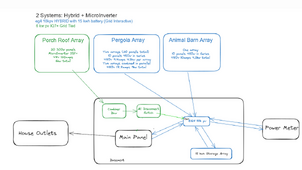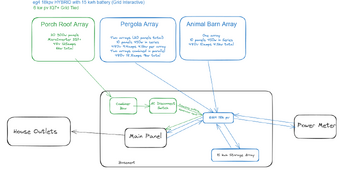the.shining
New Member
Hello,
Long time reader, first time poster here....
I'm attempting to take the best parts of both microinverter and hybrid systems. Will the system I've designed in the picture work? I've seen some variations of this system discussed but nothing exactly...
I want all my home circuits (Main Panel) to take in power from 2 distinct and separated solar systems:
- 20 panel IQ7+ enphase microinverter system
- 30 panel eg4 18kw pv all-in-one hybrid inverter system
The EG4 18k which will:
- harvest 13.5 kw pv from 30 panels
- house the automatic switch preventing back flow into grid
- manage load sharing from 15kwh storage array
The IQ7+ Microinverter system will:
- harvest 6kw pv from 20 panels
- provide better protection against periodic shading which this location suffers from
- provide rapid inverter shutdown technology at the panel
- provide some diversification of inverter failure
Questions:
Is there going to be an issue having one type of inverter sine wave from the iq7+ system meeting at the Main Panel which is also being fed by the eg4 18k pv hybrid inverter?
Would the IQ7+ stay on in case of grid failure? (pretty sure the eg4 18kpv handles the switching from grid to battery effortlessly, but I've heard the iq7+ can still try to shut down even if a sine wave from another inverter is present)
My diagram includes arrows which designate which direction electricity can flow...would these flow directions be acceptable or would they have to be ammended to avoid some problem?
Overall Goal Of My System:
It's my understanding that the EG4 18k pv can be programmed to use electricity in this order:
- first, from the IQ7+ array
- second, from the Pergola and Animal Barn array (hybrid-managed array)
- 3rd, from the battery bank
- 4th, from the grid
Other System Ideas:
If this system isn't possible, I'm interested in whatever ideas this community may know of that can accomplish the goals I've laid out...
FYI, I'm not interested in a AC coupled system because that is not a system designed to rely on the battery storage daily, with grid-assisted/automated load sharing capabilities.
Other Background Information:
This is a land and expand strategy. I use 120 kw per day in my home so I would need to expand this 20 kw system significantly in the future (either on the microinverter or hybrid arrays), but I want to start with this smaller system.

Long time reader, first time poster here....
I'm attempting to take the best parts of both microinverter and hybrid systems. Will the system I've designed in the picture work? I've seen some variations of this system discussed but nothing exactly...
I want all my home circuits (Main Panel) to take in power from 2 distinct and separated solar systems:
- 20 panel IQ7+ enphase microinverter system
- 30 panel eg4 18kw pv all-in-one hybrid inverter system
The EG4 18k which will:
- harvest 13.5 kw pv from 30 panels
- house the automatic switch preventing back flow into grid
- manage load sharing from 15kwh storage array
The IQ7+ Microinverter system will:
- harvest 6kw pv from 20 panels
- provide better protection against periodic shading which this location suffers from
- provide rapid inverter shutdown technology at the panel
- provide some diversification of inverter failure
Questions:
Is there going to be an issue having one type of inverter sine wave from the iq7+ system meeting at the Main Panel which is also being fed by the eg4 18k pv hybrid inverter?
Would the IQ7+ stay on in case of grid failure? (pretty sure the eg4 18kpv handles the switching from grid to battery effortlessly, but I've heard the iq7+ can still try to shut down even if a sine wave from another inverter is present)
My diagram includes arrows which designate which direction electricity can flow...would these flow directions be acceptable or would they have to be ammended to avoid some problem?
Overall Goal Of My System:
It's my understanding that the EG4 18k pv can be programmed to use electricity in this order:
- first, from the IQ7+ array
- second, from the Pergola and Animal Barn array (hybrid-managed array)
- 3rd, from the battery bank
- 4th, from the grid
Other System Ideas:
If this system isn't possible, I'm interested in whatever ideas this community may know of that can accomplish the goals I've laid out...
FYI, I'm not interested in a AC coupled system because that is not a system designed to rely on the battery storage daily, with grid-assisted/automated load sharing capabilities.
Other Background Information:
This is a land and expand strategy. I use 120 kw per day in my home so I would need to expand this 20 kw system significantly in the future (either on the microinverter or hybrid arrays), but I want to start with this smaller system.






